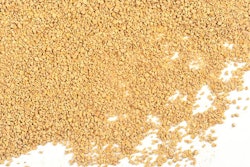
Though not widely used, sorghum’s nutritive value is similar to corn’s
The ongoing crisis in the corn market has forced producers and nutritionists to think outside the proverbial box. One alternative to corn is sorghum which, although hardly a new ingredient, is far from being commonly used.
The chemical composition and nutritive value of sorghum, and especially that of milo, is quite similar to that of corn. The nutritive value (energy) of milo is usually taken at 90% to 100% compared to corn, with a value of 96% being most common. Milo contains slightly more protein (11%-13%) than corn, but its protein profile is comparably deficient in lysine and threonine. Carcass firmness from sorghum-fed animals is similar to that of corn-fed animals, which in turn is rather softer compared with wheat/barley-fed animals. Sorghum contains no carotenes and thus fat from sorghum-fed animals is whiter compared to fat from corn-fed animals.
The palatability of sorghum is affected by the presence of tannins (condensed) and other bitter substances, which serve as a deterrent against birds on the field. The concentration of tannins in yellow seed varieties ranges from 0.2% to 0.5%, whereas that of most brown-seed varieties from 0.5% to more than 3%. Although seed color is a good initial indicator of tannin concentration, the concentration of tannins in many modern brown-seed varieties may be as low as that in yellow-seed varieties. Also, milo usually contains less tannins than dari types of sorghum.
Tannins not only reduce palatability and subsequently feed intake and growth, but they also reduce amino acid digestibility in the gastrointestinal tract, further impairing animal performance. The only practical solution to the problem of tannins is to use varieties low in tannins, and thus proper characterization of bought sorghum is imperative.

















